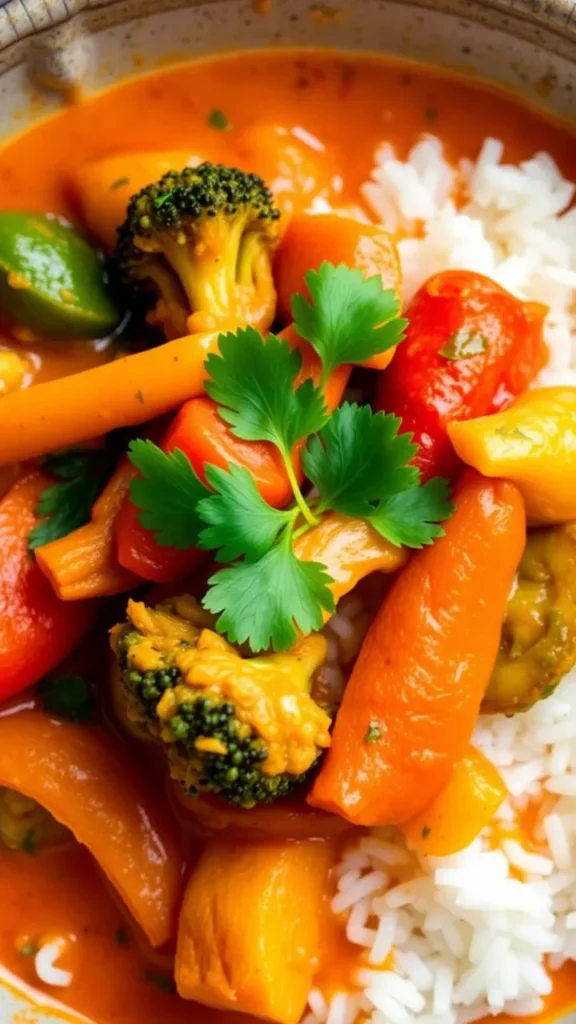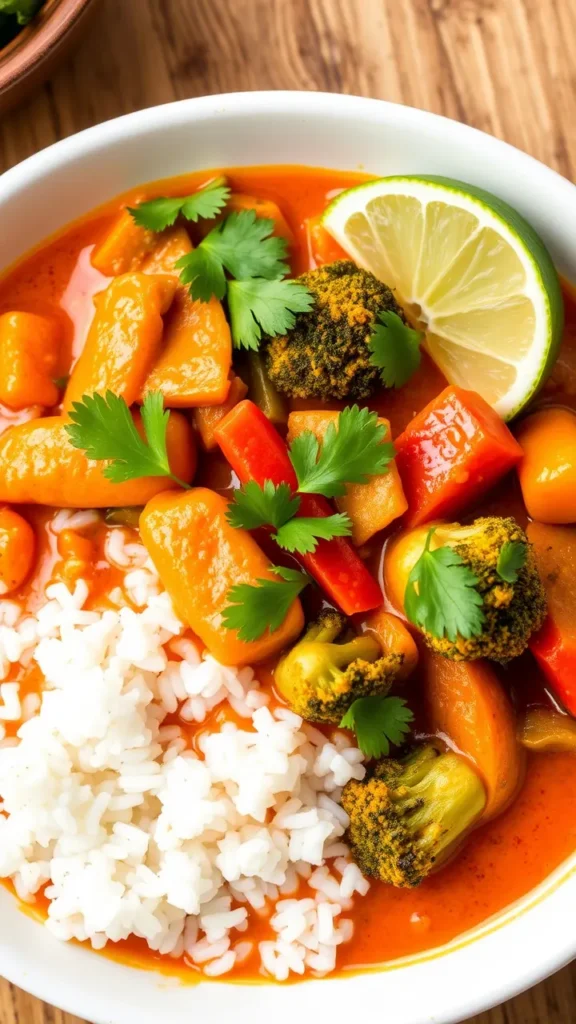Thai red curry with vegetables stands out as a vibrant and flavorful vegetarian dish in Thai cuisine. This plant-based curry combines the boldness of red curry paste, the creaminess of coconut milk, and an assortment of fresh vegetables to create a harmonious blend of spicy, sweet, savory, and creamy flavors. Its versatility makes it perfect for vegetarians, vegans, or anyone seeking a healthy, satisfying meal. The dish’s rich textures and aromatic spices make it a standout option for weeknight dinners or special occasions. Whether served with steamed jasmine rice or enjoyed on its own, Thai red curry with vegetables delivers a nourishing and indulgent experience that captures the essence of authentic Thai cooking.
Key Ingredients in Thai Red Curry with Vegetables
Red Curry Paste
The foundation of Thai red curry with vegetables lies in its curry paste. For an authentic touch, make homemade paste by blending dried chilies, lemongrass, galangal, garlic, and shrimp paste or opt for vegan alternatives like miso paste. If time is limited, store-bought paste offers convenience, but choose high-quality brands with minimal additives. A well-prepared curry paste ensures maximum flavor and aroma, setting the stage for a rich and aromatic dish. Thoughtfully selected curry paste recipes ensure your curry remains true to its Thai roots while catering to dietary preferences.
Coconut Milk
Full-fat coconut milk is essential for achieving the creamy richness that defines Thai red curry with vegetables. Its natural sweetness and velvety texture complement the spiciness of the curry paste, creating a balanced dish. While light coconut milk or alternatives like almond milk can be used, they may alter the dish’s authenticity and creaminess. Coconut milk not only enhances the curry’s texture but also ties all components together, ensuring a luxurious mouthfeel. Proper use of coconut milk uses guarantees your curry achieves the perfect consistency and flavor profile.
Vegetable Selection
Select a variety of vegetables to add color, texture, and nutrition to your Thai red curry with vegetables. Popular choices include bell peppers, bamboo shoots, eggplant, zucchini, carrots, and spinach. Harder vegetables like carrots and eggplant should be added first to ensure they cook evenly, while delicate vegetables like spinach or zucchini are stirred in towards the end to retain their vibrant colors and textures. Balancing textures crisp versus tender ensures a satisfying eating experience. Thoughtfully paired vegetable combinations elevate the dish, making it both visually appealing and delicious.
Essential Tools and Equipment
Cooking Tools
To craft the perfect Thai red curry with vegetables, gather essential tools like a wok or large skillet for even heat distribution. A wooden spoon or spatula ensures stirring without scratching nonstick surfaces. Measuring cups and spoons help maintain precise ingredient amounts, ensuring consistent results every time. These kitchen essentials streamline the cooking process, allowing you to focus on achieving flawless flavors and textures.
Optional Tools
A mortar and pestle is ideal for grinding fresh curry paste, releasing the full potential of aromatics. An immersion blender smooths out sauces for a velvety finish, while a rice cooker or pot prepares perfectly steamed jasmine rice as a side. These optional tools enhance efficiency and presentation, elevating your curry preparation to new heights. Thoughtfully chosen equipment ensures your dish shines with authenticity and precision.
Step-by-Step Recipe Instructions
Preparing the Base
Begin by sautéing red curry paste in oil over medium heat to release its fragrant aromas. Gradually add coconut milk, stirring continuously to create a creamy base. This step ensures the curry develops a rich, flavorful foundation that ties all components together. Properly prepared bases set the stage for assembling your Thai red curry with vegetables, ensuring it’s as aromatic as it is delicious.
Cooking the Vegetables
Add harder vegetables like carrots and eggplant to the simmering curry base, cooking until tender-crisp. Stir in delicate vegetables like spinach or zucchini towards the end to retain their vibrant colors and textures. This step ensures your curry is packed with nutrients and layers of flavor. Thoughtful vegetable cooking tips guarantee each ingredient shines in the final dish.
Finishing Touches
Season the curry with soy sauce, sugar, and lime juice to achieve the perfect balance of salty, sweet, and tangy flavors. Garnish with fresh basil leaves, cilantro, or lime wedges before serving for a pop of color and freshness. These finishing touches elevate your Thai red curry with vegetables, ensuring it’s as visually appealing as it is flavorful.
Creative Variations of Thai Red Curry with Vegetables
Protein Additions
Elevate your Thai red curry with vegetables by adding protein-rich ingredients like tofu, tempeh, chickpeas, or edamame. These plant-based proteins make the dish more filling while keeping it vegetarian or vegan. Tofu and tempeh absorb the flavorful curry sauce, adding depth to each bite, while chickpeas and edamame provide a hearty texture. These protein additions ensure your curry is not only nutritious but also satisfying enough to serve as a main course.
Spice Level Adjustments
Customize the heat of your Thai red curry with vegetables to suit your taste. For extra spice, incorporate more curry paste, fresh chilies, or chili flakes, adjusting gradually to avoid overpowering the dish. If you prefer milder flavors, reduce the amount of curry paste or omit spicy elements entirely. These spice adjustments allow you to tailor the dish to your preference, whether you crave bold heat or subtle warmth.
Suggested Pairings and Serving Ideas
Sides
Serve your Thai red curry with vegetables with steamed jasmine rice, brown rice, or rice noodles for a satisfying base. Add variety with sides like cucumber salad, papaya salad, or spring rolls, which provide refreshing contrast to the rich curry. These side dishes enhance the overall dining experience, making the meal feel complete and balanced.
Beverages
Pair your curry with beverages that complement its flavors. Thai iced tea, cold beer, or sparkling water offers a refreshing contrast, while herbal teas or coconut water provide hydration and balance. These beverage suggestions create harmony between flavors, ensuring a cohesive and enjoyable dining experience.
Plating Ideas
Garnish your Thai red curry with vegetables with lime wedges, red chili slices, or edible flowers for a pop of color and elegance. Serve it in traditional Thai bowls or decorative platters to enhance presentation. These plating inspiration techniques transform a simple dish into a visually stunning centerpiece, perfect for impressing guests or elevating everyday meals.
Storage and Shelf Life Tips
To maintain freshness, store leftover Thai red curry with vegetables in airtight containers in the fridge for up to three days. Reheat gently on the stovetop or microwave to preserve texture and flavor. For longer storage, freeze portions in freezer-safe containers and thaw overnight in the fridge before reheating. These curry storage tips ensure your dish remains as delicious as when freshly made.
See Also:
FAQs Section
Can I use green curry paste instead of red?
Yes, but keep in mind that green curry paste has a slightly different flavor profile. It’s milder and more herbaceous compared to the bold spiciness of red curry paste. This substitution works well if you’re aiming for a subtler taste, but the dish will lack the signature heat of Thai red curry with vegetables.
How do I make my curry spicier?
Add fresh chilies, chili flakes, or extra curry paste to increase the heat. Adjust spice levels gradually, tasting as you go to avoid overwhelming the dish. These troubleshooting tips ensure your curry achieves the desired level of spiciness without compromising its balance of flavors.
Can I make this recipe ahead of time?
Yes, prepare your curry up to two days in advance and store it in the fridge. Reheat before serving to enhance the flavors. This approach simplifies meal planning, ensuring your Thai red curry with vegetables is ready to enjoy whenever needed.
Is Thai red curry gluten-free?
Ensure all ingredients, especially curry paste and sauces, are certified gluten-free. Substitute soy sauce with tamari or coconut aminos if necessary. These dietary accommodations make the recipe accessible to those with gluten sensitivities while maintaining its authentic taste.
Why Thai Red Curry with Vegetables is a Must-Try
Thai red curry with vegetables is a timeless favorite among plant-based dishes, celebrated for its bold flavors, creamy texture, and adaptability. Whether enjoyed as a comforting weeknight meal or served at gatherings, this curry never fails to impress with its vibrant colors and harmonious blend of spices. Its versatility allows for endless creativity, from protein additions to spice level adjustments, ensuring there’s a version for every palate. Experiment with variations, share your creations online, and inspire others to embrace culinary creativity. Dive into this easy recipe and discover why Thai red curry with vegetables remains an irresistible classic.
PrintThai Red Curry with Vegetables
- Total Time: 30 minutes
- Yield: 4 servings 1x
- Diet: Vegetarian
Description
A flavorful and creamy Thai red curry with vegetables, made with red curry paste, coconut milk, and a mix of fresh vegetables. This plant-based dish is perfect for vegetarians, vegans, and anyone looking for a delicious and healthy meal. Serve with jasmine rice for a complete Thai-inspired dinner.
Ingredients
Curry Base:
- 2 tbsp red curry paste (store-bought or homemade)
- 1 can (14 oz) full-fat coconut milk
- 1 tbsp vegetable oil
- 1 cup vegetable broth or water
Vegetables:
- 1 red bell pepper, sliced
- 1 zucchini, sliced
- 1 small eggplant, diced
- 1 carrot, julienned
- ½ cup bamboo shoots
- 1 cup spinach or kale
Seasoning & Garnish:
- 1 tbsp soy sauce or tamari (for gluten-free option)
- 1 tsp sugar (optional)
- 1 tbsp lime juice
- Fresh basil or cilantro for garnish
- Lime wedges for serving
Instructions
Instructions
- Prepare the Base: Heat oil in a large wok or skillet over medium heat. Add red curry paste and sauté for 1-2 minutes until fragrant.
- Add Coconut Milk & Broth: Gradually stir in coconut milk and vegetable broth, mixing until smooth. Simmer for 2-3 minutes.
- Cook the Vegetables: Add harder vegetables like carrots and eggplant first, cooking for 5 minutes. Stir in bell peppers, zucchini, and bamboo shoots, cooking for another 3-4 minutes. Finally, add spinach or kale and let it wilt.
- Season & Finish: Stir in soy sauce, sugar, and lime juice. Adjust seasoning as needed.
- Serve: Garnish with fresh basil or cilantro and serve with steamed jasmine rice and lime wedges.
Notes
- For extra protein, add tofu, tempeh, or chickpeas.
- Adjust spice level by increasing or reducing curry paste.
- Leftovers store well in the fridge for up to 3 days or can be frozen for up to 2 months.
- Prep Time: 10 minutes
- Cook Time: 20 minutes
- Category: Main Course
- Method: Stovetop
- Cuisine: Thai
Nutrition
- Serving Size: 1 bowl
- Calories: ~250
- Sugar: ~6g
- Sodium: ~500mg
- Fat: ~15g
- Saturated Fat: ~10g
- Unsaturated Fat: ~4g
- Trans Fat: 0g
- Carbohydrates: ~22g
- Fiber: ~5g
- Protein: ~4g
- Cholesterol: 0mg



